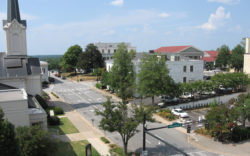Back in September, the Athens Banner-Herald ran a story entitled “Walmart: No store planned for downtown,” effectively dispelling rumors that the store was coming to the Armstrong & Dobbs property on the eastern edge of downtown. What the story hinged on, though, was a spokesman quoted only as saying “…I’m not aware of any specific discussions.” In the meantime, concerned community members were thrown off the scent. Last week, Selig Enterprises of Atlanta, the development group working on the project, requested a permit to demolish all the buildings in the project area, many of which are on the National Register of Historic Places, including the Jittery Joe’s Roaster. That move brings this project out into the light once and for all.
According to ACC Commissioner Kelly Girtz, who has met with representatives of the development team, plans call for roughly 200,000 square feet of development, including a 90,000-square-foot big-box retailer – most likely Walmart – and about 220 bedrooms worth of residential development. Apparently, this can all be built by right under existing zoning, without any chance for citizens to weigh in. For scale, the size of the big-box component alone is about twice as large as the average supermarket.
This project is one that will be highly controversial, and the developers know that – which is why they’ve moved quite discreetly, with the demolition permits being their first official act. The way the project has proceeded also raises many more interesting questions about what exactly the illegal executive session of the Economic Development Foundation in September means in context.
Mayor Nancy Denson, who has been in conversations with the developers for a while now, called that illegal meeting, and now has some explaining to do. Although the “Blue Heron” river district was itself a controversial notion, it was one that was being discussed in the public arena, with elected representatives of the citizenry ultimately driving it. For the mayor to bring that public discussion to an end, effectively clearing the way for an obviously controversial private project of which she has inside knowledge to proceed unscrutinized, is incredibly worrying. Does she work for the citizens of Athens who elected her, or for Selig Enterprises?
Downtown Athens is a gem of independent commerce, recognized nationally, and for a Walmart to be built within spitting distance of that should certainly cause alarm, especially for those involved in the local economic development conversation – and more especially for people like current Chamber of Commerce President and ousted Mayor Doc Eldridge. However, he took advantage of that illegal EDF meeting to suggest, during a conversation in which a private development was being used as the rationale for killing the river district project, that private investment in the area was unfeasible, ultimately clearing the way for a business model known for destroying Main Streets to waltz into downtown Athens.
Doc’s remained busy since then, though, and the ink was barely dry on EDF head Matt Forshee’s resignation before Eldridge began circulating a plan for his Chamber to take over the EDF. Among other things, the proposal suggests that “it is anticipated that the EDF would contribute an amount to be determined to Eldridge’s salary, expense and overhead.” Many around town were dissatisfied with the performance of both the Chamber and EDF already, and if Eldridge’s illegal actions in that meeting have effectively helped open the door to big-box developers that might outcompete local businesses, he hardly deserves a raise.
Of course, it’s not as if the river district had been the first opportunity to discuss a plan for downtown that might have left us with more recourse as a community to discuss the current project. It seems as if every recent development in the area has prompted calls to actually develop a master plan for downtown, from the Classic Center expansion to the Washington Street parking deck to 909 Broad and other student housing projects. Never, though, have our commissioners felt compelled to prepare for the inevitable.
When this thing comes online – and it looks like developers are aiming for a spring groundbreaking – what will its consequences be? Beyond the questions of what a big box store will do to the viability of existing local retail in downtown Athens, there’s also the traffic it will create. Oconee Street is already in rough shape, with only a single eastbound lane and traffic backing up even in very mild conditions. A development of this magnitude would likely push the corridor over the edge, with a ripple effect all over downtown out into surrounding neighborhoods like Potterytown, Chicopee-Dudley, East Athens and Carr’s Hill, while also further mucking up the traffic at Lexington Road and the Bypass. There’s also the question of how our adjacent Rail-to-Trail corridor, multi-modal transportation hub and other community investments will be affected.
Further, how will the project itself integrate into the community at a district level? Will this be a logical continuation of downtown, or a self-contained shopping center? The kind of retail browsing that makes downtown’s network of small shops work is a fundamentally different business model from the one-stop-shop big box that the 90,000 square feet figure suggests. The southeast approach into downtown Athens will now be entrusted to these developers, and given that they’ve made no effort to involve the community in this project, it’s unlikely that the development will be representative of our identity and sense of place, upon which so many other aspects of our economy hinge.
So, what chance does the community have to voice its opinion on this project? The most effective place to begin may be to start talking about these historic buildings. This project will wipe out a large part of our National Register Warehouse Historic District. According to Girtz, the big box is to be located on the eastern end of the site, while those historic buildings are clustered to the northwest. There’s no reason why the affiliated retail and residential spaces that will accompany the big box component can’t reuse these buildings, incorporating them into a more organic neighborhood fabric that feels like an extension of downtown, rather than an independent shopping center plopped into the middle of the city. If the community wants to start talking about this site, that’s the place to start.
Of course, this shouldn’t be a referendum on Walmart. The question is whether or not the community should get a say in its own future. It’s about not being given a chance to put our values on the table. Maybe a corporate big-box superstore is a good fit for downtown Athens, and maybe it isn’t. That’s a conversation we need to have. None of our elected leaders have yet shown much interest in that idea, though, and they seem to be putting a lot of faith in these developers to do the right thing. If this project turns out all right, we should consider ourselves very, very lucky.
Like what you just read? Support Flagpole by making a donation today. Every dollar you give helps fund our ongoing mission to provide Athens with quality, independent journalism.










